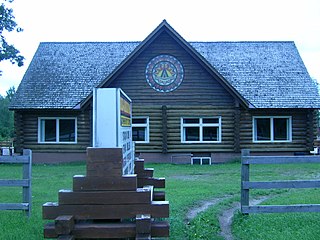
The Province of Upper Canada was a part of British Canada established in 1791 by the Kingdom of Great Britain, to govern the central third of the lands in British North America, formerly part of the Province of Quebec since 1763. Upper Canada included all of modern-day Southern Ontario and all those areas of Northern Ontario in the Pays d'en Haut which had formed part of New France, essentially the watersheds of the Ottawa River or Lakes Huron and Superior, excluding any lands within the watershed of Hudson Bay. The "upper" prefix in the name reflects its geographic position along the Great Lakes, mostly above the headwaters of the Saint Lawrence River, contrasted with Lower Canada to the northeast.

The Ojibwe, Ojibwa, Chippewa, or Saulteaux are an Anishinaabe people in what is currently southern Canada, the northern Midwestern United States, and Northern Plains.

Bruce County is a county in Southwestern Ontario, Canada comprising eight lower-tier municipalities and with a 2016 population of 66,491. It is named for James Bruce, 8th Earl of Elgin and 12th Earl of Kincardine, sixth Governor General of the Province of Canada. The Bruce name is also linked to the Bruce Trail and the Bruce Peninsula. It has three distinct areas. The Peninsula is part of the Niagara Escarpment and is known for its views, rock formations, cliffs, and hiking trails. The Lakeshore includes nearly 100 km of fresh water and soft sandy beaches. Finally, the Interior Region has a strong history in farming.

The Wiikwemkoong First Nation is a First Nation on Manitoulin Island in Northern Ontario. The Wiikwemkoong Unceded Territory is the First Nation reserve in the northeast of Manitoulin Island in Manitoulin District, Ontario, Canada. Wiikwemkoong is an unceded Indigenous reserve in Canada, which means that it has not "relinquished title to its land to the government by treaty or otherwise."

Garden River First Nation, also known as Ketegaunseebee, is an Ojibwa band located at Garden River 14 near Sault Ste. Marie, Ontario, Canada.
The Robinson Treaties are two treaties signed between the Ojibwa chiefs and The Crown in 1850 in the Province of Canada. The first treaty involved Ojibwa chiefs along the north shore of Lake Superior, and is known as the Robinson Superior Treaty. The second treaty, signed two days later, included Ojibwa chiefs from along the eastern and northern shores of Lake Huron, and is known as the Robinson Huron Treaty. The Wiikwemkoong First Nation did not sign either treaty, and their land is considered "unceded".

Chippewas of Sarnia Band v Canada (AG), 2000 CanLII 16991, 51 OR (3d) 641; 195 DLR (4th) 135 was a decision of the Court of Appeal for Ontario concerning aboriginal title in Canada.

Chippewas of Rama First Nation, also known as Chippewas of Mnjikaning and Chippewas of Rama Mnjikaning First Nation, is an Anishinaabe (Ojibway) First Nation located in the province of Ontario in Canada. The name Mnjikaning, or fully vocalized as Minjikaning, refers to the fishing weirs at Atherley Narrows between Lake Simcoe and Lake Couchiching and it means "in/on/at or near the fence".

The Teme-Augama Anishnabai is the Indiginous Anishinaabe community of the Temagami First Nation. The Teme-Augama Anishnabai have trapped and hunted animals in the Temagami region of Canada for over 5,000 years. Bear Island on Lake Temagami is home to the Aboriginal community.

Fort William First Nation is an Ojibwa First Nation reserve in Ontario, Canada. The administrative headquarters for this band government is south of Thunder Bay. As of January 2008, the First Nation had a registered population of 1,798 people, of which their on-Reserve population was 832 people.
The Temagami First Nation is located on Bear Island in the heart of Lake Temagami. The island is the second largest in Lake Temagami, after Temagami Island. Its community is known as Bear Island 1. Temagami First Nation (TFN) members are status Indians under the Indian Act that live on and off Bear Island.
Gary Potts was a chief of the Temagami First Nation and the Teme-Augama Anishnabai in Temagami, Ontario, Canada. He was chief in August 1973 when the Temagami Land Caution began with land claims being filed with title offices to prevent development on Crown land.

Gull Bay First Nation or Kiashke Zaaging Anishinaabek is an Anishinaabe (Ojibway) First Nation band government located in Thunder Bay District in northwestern Ontario, Canada. It is approximately 175 kilometres (109 mi) north of Thunder Bay, Ontario on Highway 527 on the western shore of Lake Nipigon. As of May 2010, the First Nation had a registered population of 1,149 people, including an on-Reserve population of 328.
R. v. Powley, 2003 SCC 43, commonly called the Powley ruling, is a Supreme Court of Canada case defining Métis Aboriginal rights under section 35(1) of the Constitution Act, 1982.

Legal Aid Ontario (LAO) is a publicly funded and publicly accountable non-profit corporation, responsible for administering the legal aid program in the province of Ontario, Canada. Through a toll-free number and multiple in-person locations such as courthouse offices, duty counsel and community legal clinics, the organization provides more than one million assists to low-income Ontario residents each year.

That Portion of the Cayuga Indians Residing in Canada v. State, 1 N.E. 770, was an early litigation of aboriginal title in New York, with the Canadian Cayugas seeking to recovery compensation from a prior land cession.
The Temagami Land Caution was a territorial dispute in the Temagami area of Northeastern Ontario, Canada. The land claim was filed with land title offices in August 1973 by Gary Potts, then Chief of the Teme-Augama Anishnabai an Aboriginal community. The caution was intended as a way of maintaining 10,000 km2 (3,900 sq mi) of land that they claimed as "n'Daki Menan", meaning "Our Land". Existing throughout much of the 1970s and 1980s, it effectively prevented all types of development on Crown land, such as mining. Crown land sales were also prohibited due to the Temagami Land Caution. In 1988, Vince Kerrio approved the expansion of Red Squirrel Road directly through the Temagami Land Caution. This prompted a series of roadblocks by the Teme-Augama Anishnabai and by environmentalists in 1988-1989. In 1991, the Supreme Court of Canada ruled that the Teme-Augama Anishnabai gave up rights to the land via the 1850 Robinson Treaty despite the Tema-Augama Anishnabai claiming that they never signed or consented to the treaty. The Temagami Land Caution was lifted in 1995 as a result of a court order by the Supreme Court of Canada.
The Batchewana First Nation of Ojibways is an Ojibway First Nation in northern Ontario. Their traditional lands run along the eastern shore of Lake Superior, from Batchawana Bay to Whitefish Island. They were reserved this land in the 1850 Robinson Huron Treaty, but surrendered most of it under the 1859 Pennefather Treaty. Through purchase and land claims, it has reclaimed some territories, including Goulais Bay 15A, Obadjiwan 15E, Rankin Location 15D and Whitefish Island.
Shawanaga First Nation is an Anishinaabe First Nation band government in central Ontario near Nobel. Its reserves include:

Ignace Tonené, also known as Nias and Maiagizis, was a Hudson's Bay Company employee, a fur trader, a gold prospector, and the chief of the Teme-Augama Anishnabai community.












